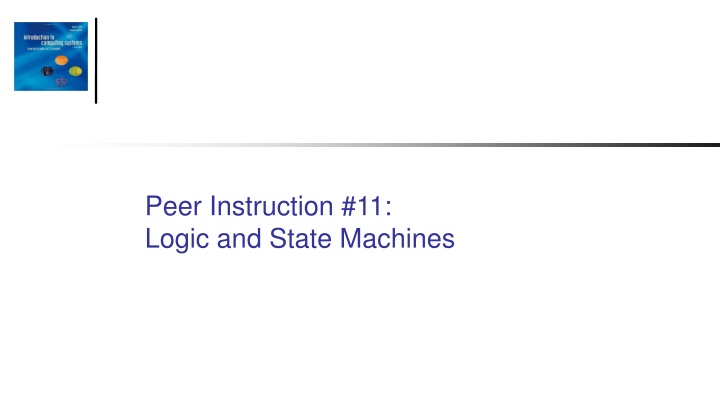
Logic and State Machines: Understanding Sequential Circuits and Control Signals
Explore concepts related to state machines, D latches, combinational logic, and register transfers in digital circuits. Learn about Mealy and Moore machines, D latch operation, sequential circuit behavior, and bus architecture in LC3 systems. Dive into the world of logical circuits and control signals.
Download Presentation

Please find below an Image/Link to download the presentation.
The content on the website is provided AS IS for your information and personal use only. It may not be sold, licensed, or shared on other websites without obtaining consent from the author. If you encounter any issues during the download, it is possible that the publisher has removed the file from their server.
You are allowed to download the files provided on this website for personal or commercial use, subject to the condition that they are used lawfully. All files are the property of their respective owners.
The content on the website is provided AS IS for your information and personal use only. It may not be sold, licensed, or shared on other websites without obtaining consent from the author.
E N D
Presentation Transcript
Peer Instruction #11: Logic and State Machines
If implemented as discussed in lectures what type of state machine could have the output vary during one clock cycle? A. Mealy B. Moore C. All of the above D. None of the above
How many bits of information does a D latch store? When will the input to a D latch become the output, assuming the WE line is asserted? A. 2 bits, in the current clock cycle B. 1 bit, in the next clock cycle C. 1 bit, after some propagation delay D. 2 bits, in the next clock cycle E. None of the above
How many bits of information does a D latch store? When will the input to a D latch become the output, assuming the WE line is asserted? https://www.cs.colostate.edu/~cs270/.Spring20/resources/memory.circ
A sequential circuit has two flip-flops with inputs DA and DB. The combinational logic is described by the equations: DA = AB X + A X + A B , DB = A X + BX and is currently in state A,B = 0,0 if the input x is 1, the next state will be A. A=0, B=0 B. A=0, B=1 C. A=1, B=0 D. A=1, B=1 E. None of the above
The third cycle of the Fetch phase moves data between which registers A. IR <- PC B. PC <- MAR C. IR <- MDR D. MDR <- MAR E. None of the above
The LC3s Global Data Bus can have multiple input sources in the same clock cycle? How about multiple output destinations? A. No, No B. No, Yes C. Yes, No D. Yes, Yes E. None of the above
What control signal is not needed for this register transfer PC <- ZEXT(IR[7:0]) A. MARMUX B. GATEMARMUX C. LD.PC D. GatePC E. PCMUX
What is the result of adding the following 2s comp values in Hex 0x81FA + 0x78 Assume the second value is stored in 8 bits and use sign extension if necessary A. 0x78FA B. 0x8272 C. 0x8172 D. 0x181F2 E. None of the above
A Control Store is used in the LC3 to generate the outputs of a current state and data related to the next state. If implemented in memory a Control Store cannot be updated A. False, False B. False, True C. True, False D. True, True
A D flip-flop is composed of how many D latches. What is the advantage of a D flip-flop over a D latch A. .5, input value is available immediately as output B. 2, input value does not become the output until the next clock cycle C. 1, no advantage they are just two words that describe the same device D. 2, input value is available immediately as output E. None of the above
A D flip-flop is composed of how many D latches. What is the advantage of a D flip-flop over a D latch https://www.cs.colostate.edu/~cs270/.Spring20/resources/memory.circ
What Karnaugh Map corresponds to the following truth table A B A 0 0 0 0 1 1 1 1 B 0 0 1 1 0 0 1 1 C 0 1 0 1 0 1 0 1 X 1 0 1 0 0 0 1 1 D C X
What truth table corresponds to the circuit? A B A 0 0 0 0 1 1 1 1 B 0 0 1 1 0 0 1 1 In 0 1 0 1 0 1 0 1 X 0 1 0 0 1 1 1 0 Y 0 0 0 0 0 1 1 0 A 0 0 0 0 1 1 1 1 D B 0 0 1 1 0 0 1 1 In 0 1 0 1 0 1 0 1 X 0 1 0 1 1 0 1 0 Y 0 0 0 1 0 0 1 0 C X A 0 0 0 0 1 1 1 1 B 0 0 1 1 0 0 1 1 In 0 1 0 1 0 1 0 1 X 0 0 0 1 1 0 0 0 Y 0 0 0 1 1 0 1 0 A 0 0 0 0 1 1 1 1 B 0 0 1 1 0 0 1 1 In 0 1 0 1 0 1 0 1 X 1 1 0 1 1 0 1 0 Y 0 0 1 1 0 0 1 0
